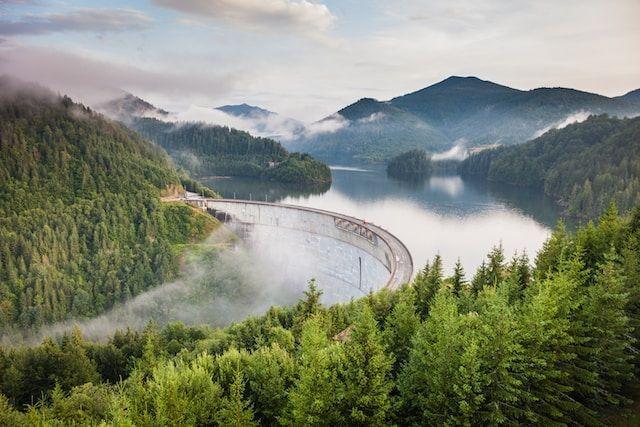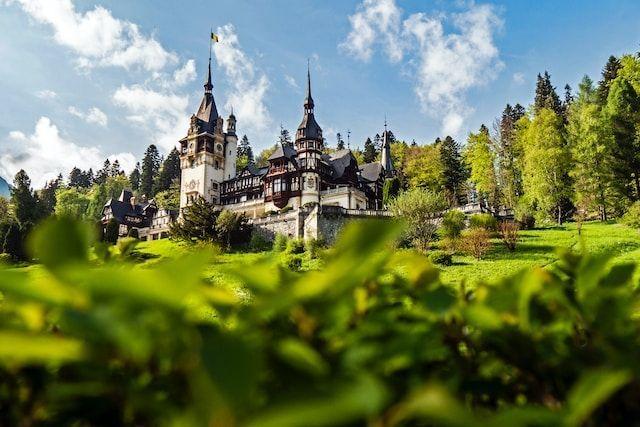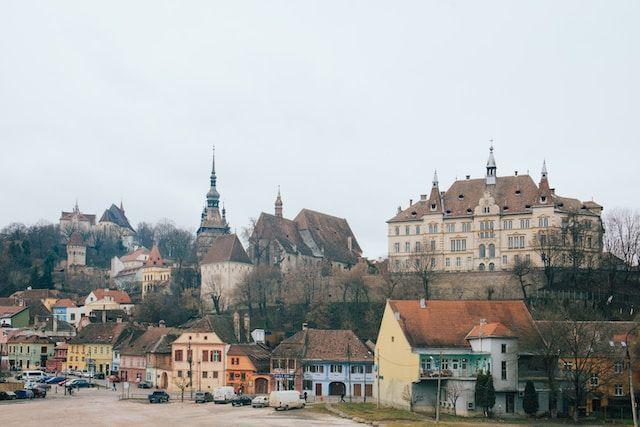Romania Travel Guide: Notes to Discover Romania
Romania offers visitors a unique combination of natural beauty and cultural heritage. In this Romania travel guide you will find the necessary information to plan your trip.
General Information about Romania
If you are considering a vacation in Romania, here you will find everything you need to make your dream come true.
Romania is a country located in southeastern Europe, bordered by Ukraine to the north, Moldova to the northeast, Hungary to the west, Serbia to the southwest, and Bulgaria to the south. Its capital and largest city is Bucharest.
With a population of approximately 19.5 million people, Romania is the seventh most populous member state of the European Union. Its official language is Romanian, and its currency is the Romanian leu.
Romania has a diverse geography, including the Carpathian Mountains, the Danube River, and the Black Sea coast. The country is known for its natural beauty, including the stunning painted monasteries of Bucovina, the ancient Dacian ruins of Sarmizegetusa Regia, and the UNESCO-protected Danube Delta.
The country’s history is rich and varied, with influences from the Romans, the Byzantine Empire, the Ottoman Empire, and the Austro-Hungarian Empire, among others. Romania became a communist state after World War II, but overthrew its communist government in 1989 and transitioned to a market economy.
Today, Romania is a member of the European Union, NATO, and the United Nations, and is known for its contributions to science, culture, and sports.

Water mirror surrounded by mountains and vegetation
Picture of paul mocan on Unsplash
Location of Romania
Here's where Romania is located:
Map of Romania on Google Maps
Places of Interest to Visit in Romania
Would you like to visit Romania the best way? Then, here we tell you the most wonderful places of this destination, with a rich history and culture and fascinating landscapes, so that you don’t miss a thing during your journey.
Bran Castle
This medieval fortress is located near Brasov and is commonly known as Dracula’s Castle. It is one of the most visited tourist attractions in Romania.
Palace of the Parliament
This massive government building in Bucharest is one of the largest administrative buildings in the world. It was built during the communist era and is open to visitors.
Peles Castle
This Neo-Renaissance castle in the Carpathian Mountains was the summer residence of the Romanian royal family. It is now a museum and open to visitors.

Castle surrounded by nature
Picture of Majkl Velner on Unsplash
Danube Delta
This is the second-largest river delta in Europe and a UNESCO World Heritage site. It is a unique and biodiverse area with many species of birds, fish, and other wildlife.
Painted Monasteries of Bucovina
These beautiful monasteries, located in the northern part of Romania, are decorated with intricate frescoes and are also UNESCO World Heritage sites.
Sighisoara
This medieval town in Transylvania is the birthplace of Vlad the Impaler, the inspiration for Bram Stoker’s Dracula. It has a well-preserved historic center and is a UNESCO World Heritage site.
Corvin Castle
This Gothic castle in Hunedoara is one of the largest and most impressive castles in Romania. It is also known as Hunyadi Castle.
Transfagarasan Highway
This scenic mountain road winds through the Carpathian Mountains and offers breathtaking views of the surrounding landscape.
Merry Cemetery
This unique cemetery in Sapanta is famous for its brightly painted wooden crosses with humorous epitaphs.
The Apuseni Mountains
This mountain range in western Romania is a popular destination for outdoor activities like hiking, caving, and skiing.
What to Eat and Drink in Romania
Romanian cuisine is a reflection of its diverse cultural heritage, with influences from neighboring countries like Hungary and Serbia, as well as Ottoman and other Eastern European cuisines.
The food is hearty and flavorful, with a focus on meat dishes like grilled sausages and stews, often accompanied by traditional sides like polenta or cabbage rolls. Vegetarian options are also available, such as stuffed bell peppers or vegetable soups.
Romania is also known for its wide variety of dairy products, including creamy cheeses and yogurts. Baked goods are also a staple of the cuisine, with sweet pastries like cozonac or savory pies like placinte.
To drink, Romania is famous for its wine, particularly the red wines of the Murfatlar region. Traditional beverages like tuica, a strong plum brandy, and horinca, a type of fruit brandy, are also popular. Coffee and tea are also widely consumed, often served with a sweet pastry or cake.
Overall, dining in Romania is an experience that combines hearty, flavorful dishes with a rich cultural heritage and warm hospitality.
Living the Culture in Romania
Romanian culture is a blend of its diverse history and influences from neighboring countries.
Family and community are highly valued, with strong ties between generations and a sense of mutual support. Hospitality is also an important part of the culture, with guests often greeted warmly and offered food and drink.
Art and music are also integral parts of Romanian culture, with a rich tradition of folk music, dance, and crafts. Traditional costumes, often featuring intricate embroidery and bright colors, are still worn on special occasions and celebrations.
Religion plays a significant role in Romanian culture, with the majority of the population identifying as Eastern Orthodox Christians. Religious festivals and traditions are an important part of the cultural calendar.
Education is highly valued in Romanian culture, with a strong emphasis on science and technology, as well as the humanities. Literature and poetry have a long and respected tradition, with Romanian writers and poets often celebrated for their contributions to the arts.
To summarize, Romanian culture is characterized by a strong sense of community and family, a rich artistic tradition, and a deep respect for education and intellectual pursuits.
How to Get to Romania
There are several ways to get to Romania, depending on your starting point and preferences. Here are some of the most common options:
- By plane: Romania has several international airports, including Bucharest Henri Coandă International Airport, Cluj-Napoca International Airport, and Timișoara Traian Vuia International Airport, among others. Major airlines such as Lufthansa, Air France, and Turkish Airlines, as well as low-cost carriers like WizzAir and Ryanair, operate regular flights to Romania from many European cities and beyond.
- By train: Romania is well-connected to neighboring countries by train, with daily services to and from Hungary, Bulgaria, Serbia, Ukraine, and Moldova. The national railway company is called CFR (Căile Ferate Române) and offers both domestic and international services.
- By bus: Several international bus companies operate services to Romania from major European cities, such as Flixbus and Eurolines. Domestic bus services are also available, with several companies offering routes between major Romanian cities.
- By car: Romania has a well-maintained network of highways and national roads that connect major cities and towns. However, road conditions in some rural areas may be less developed, so it’s important to check the latest travel information and plan accordingly.
- By boat: Cruise ships and ferries operate between Constanta on the Black Sea coast and other ports in the region, such as Odessa in Ukraine and Istanbul in Turkey.
How to Get Around Romania?
If you wonder how to get around Romania, you should know that this area has several options available to move around the area and explore its wonders.
By car
Renting a car is a popular option for travelers who want to explore Romania at their own pace. The major international car rental companies, such as Avis, Hertz, and Europcar, have offices in major cities and airports. However, it’s worth noting that driving in Romania can be challenging, particularly in rural areas with narrow and winding roads.
By train
The national railway company, CFR (Căile Ferate Române), operates regular services between major cities and towns in Romania, as well as international routes to neighboring countries. Trains in Romania are generally affordable and comfortable, with options ranging from local trains to express services.
By bus
Domestic and international bus services are available, with several companies offering routes between major Romanian cities and towns. Buses are generally a more affordable option than trains, but may be slower and less comfortable.
By metro
Bucharest has a modern and efficient metro system that connects many parts of the city. Other major cities, such as Cluj-Napoca and Timișoara, also have smaller metro systems.
By taxi
Taxis are widely available in major cities and towns, but it's important to use licensed and reputable companies to avoid scams and overcharging. Uber and other ride-sharing apps are also available in some cities.
By bicycle
Cycling is becoming increasingly popular in Romania, particularly in urban areas where bike lanes are being developed. Several cities, such as Timișoara and Sibiu, have public bike-sharing schemes that are a convenient and affordable way to get around.
Private Transfer
If you are looking for the most practical and safest option to get to Romania and visit the places of interest of this destination, here you will find the information you need to book your private transfer with Greca.
Best Time to Visit Romania
The best time to visit Romania depends on your preferences and what you want to do during your trip. Generally, the best time to visit Romania is during the shoulder seasons of spring (April-June) and fall (September-November), when the weather is mild and pleasant, and the crowds are smaller.
However, if you’re interested in winter sports or Christmas markets, then winter (December-February) can also be a great time to visit.
Here are some factors to consider when deciding the best time to visit Romania:
- Weather: The weather in Romania can be quite variable, with hot summers and cold winters. The shoulder seasons of spring and fall offer milder temperatures and fewer crowds, while summer can be hot and crowded, particularly in popular tourist destinations.
- Festivals and events: Romania hosts several festivals and events throughout the year, such as the Transylvania International Film Festival in Cluj-Napoca, the Sibiu International Theatre Festival, and the Medieval Festival în Sighișoara. If you’re interested in attending any of these events, then it’s worth planning your trip accordingly.
- Outdoor activities: If you’re interested in hiking, cycling, or other outdoor activities, then the shoulder seasons of spring and fall offer pleasant weather and fewer crowds. Winter can be a great time for skiing and snowboarding in the Carpathian Mountains.
- Cultural attractions: Many of Romania’s cultural attractions, such as castles and museums, are open year-round, but may have shorter opening hours in the off-season. It’s worth checking the opening times of any attractions you're interested in visiting before planning your trip.
Festivals of Romania
Romania has a rich and diverse cultural calendar, with many festivals and celebrations throughout the year. Here are some of the most important festivals in Romania:
Bucharest International Film Festival
This film festival, held annually in Bucharest, showcases independent films from around the world.
Sighisoara Medieval Festival
This festival, held in the historic town of Sighisoara, celebrates the town’s medieval history with parades, music, and costumed reenactments.

Picturesque medieval constructions
Picture of Alisa Anton on Unsplash
George Enescu Festival
This classical music festival, held in honor of the Romanian composer George Enescu, brings together top performers from around the world for a series of concerts and events.
The Feast of St. Andrew
This religious festival, celebrated on November 30th, is a night of traditional customs and rituals, including fortune-telling and lighting bonfires.
Romanian Peasants Day
This celebration, held on June 24th, honors the country’s agricultural heritage with traditional dances, costumes, and food.
Transylvania International Film Festival
This film festival, held annually in Cluj-Napoca, showcases international and Romanian films.
Brasov Marathon
This sporting event, held annually in Brasov, features both amateur and professional runners competing in a variety of races.
Bear Dance Festival
This unique festival, held in the village of Comanesti, involves locals dressed in bear costumes performing a traditional dance to drive away evil spirits and bring good luck.
Wine Festival
Held in various locations throughout the country, this festival celebrates Romania’s long tradition of winemaking with tastings, music, and food.
Is It Worth Visiting Romania?
Of course! Romania stands out for its incredible landscapes and the warmth of its people. In addition, the region is known for its fascinating festivals and its historical buildings.
In turn, due to its proximity to Sofia and Belgrado, many travelers combine their visit to Romania with these destinations, so you will find these sites in several of our offers.
Are you looking to marvel at the most incredible landscapes? Do you want to know a fascinating culture? Do you want to enjoy incredible gastronomy?
If your answer is "yes", at Greca we have several proposals for tourist packages to Romania, which you can modify and adapt according to your needs and times.
There are travel packages for all tastes. Choose your own adventure according to your needs!
More Travel Guides!
If you have been interested in our travel guide to Romania and want to continue learning about this and other wonderful destinations, we invite you to look at the section of all our Travel Guides. Plan your next adventure with Greca!